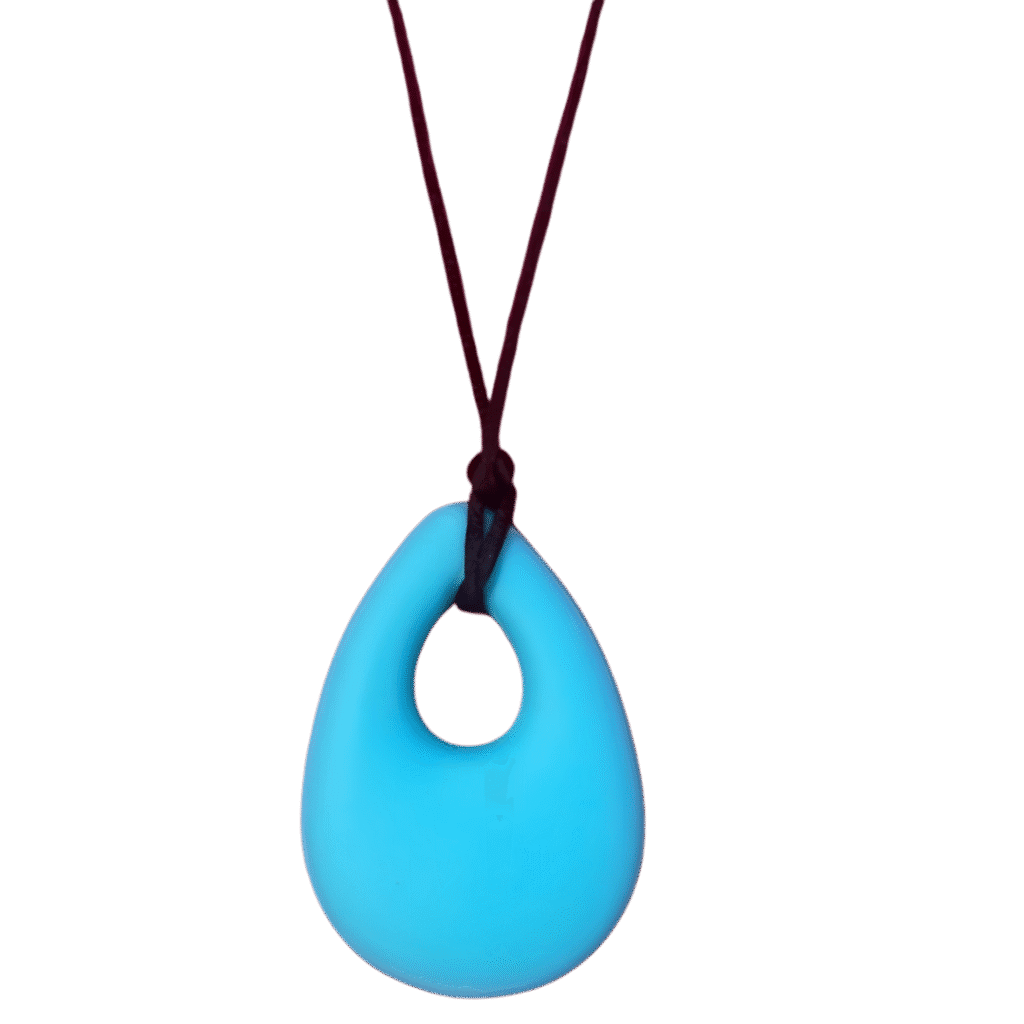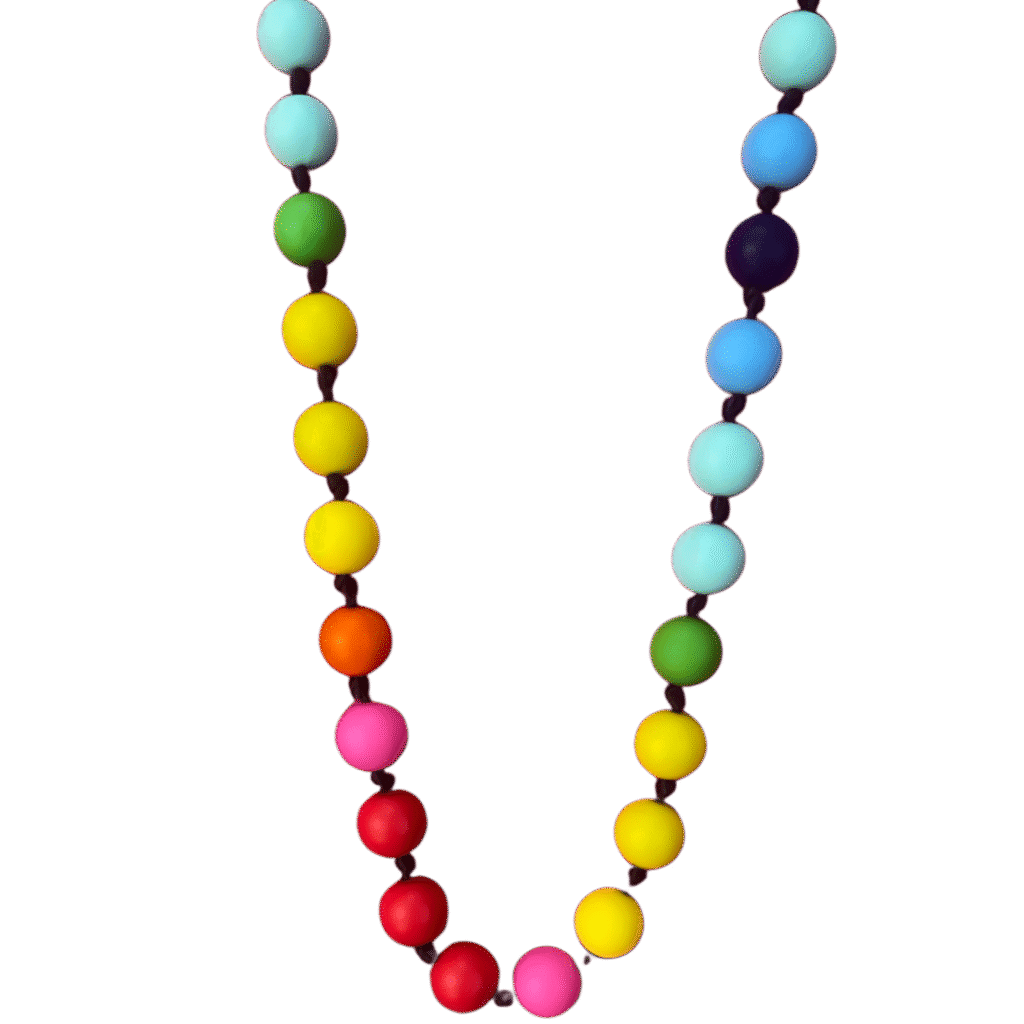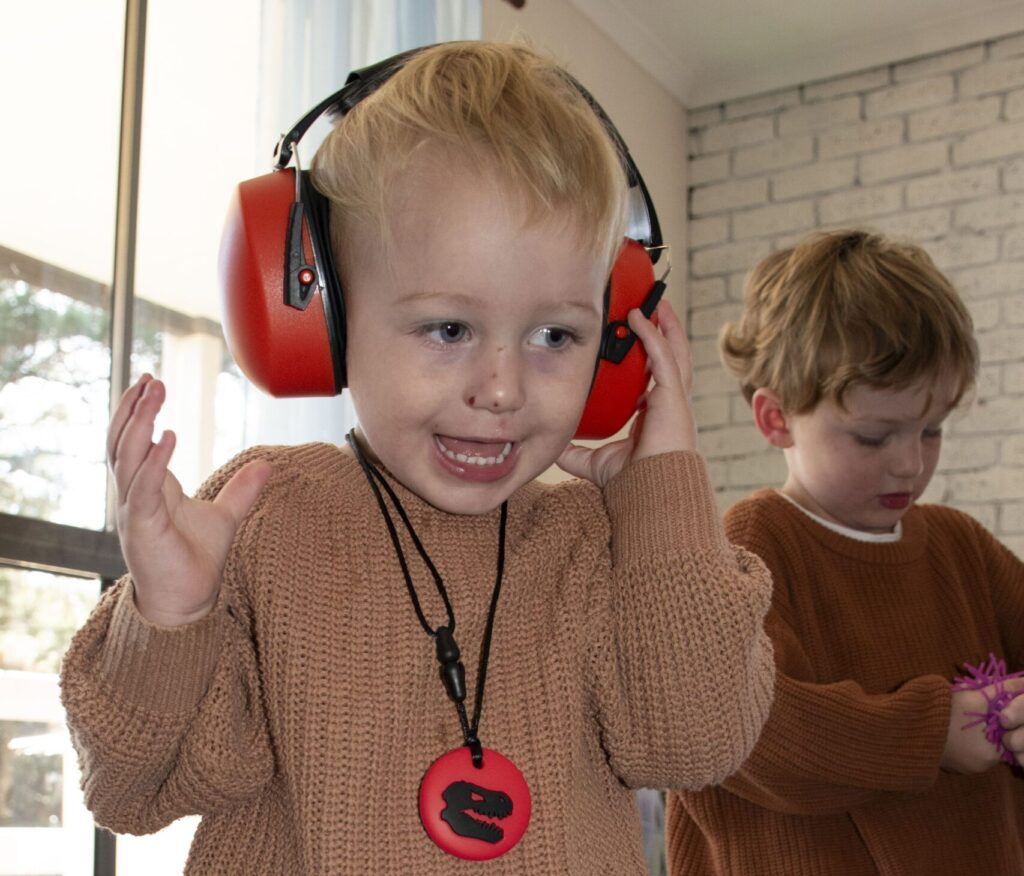
Shirt collars, hoodie strings, pencil tops – if you work in a Melbourne classroom or clinic, you’ve seen them chewed. That’s not “bad behaviour”; it’s oral sensory seeking. When the mouth is craving input, attention wanders, sleeves get soggy, and uniforms wear out fast. A chewy necklace gives the mouth a job it can do safely and quietly so the brain can get back to learning, listening, and playing.
At Sensory Beez we stock clinic-friendly chewelry in multiple shapes and densities so you can match the tool to the child, not the other way around. Start here if you need a quick shortlist:
• Chewy Crocodile Necklace – textured option many strong chewers prefer: View

• Chewy Pendant Necklace – discreet, smooth pendant for steady jaw work: View

• Chewy Necklace (Classic) – versatile everyday pick with breakaway clasp: View

Need advice for firmness and shape, or a quick school/NDIS quote? WhatsApp our team. You can also browse everything here: Shop All.
Why oral input helps (and when to use it)
Chewing delivers strong, predictable signals through the jaw (TMJ) and facial muscles. Those proprioceptive signals are organising: they often reduce fidgeting and improve focus during listening, handwriting, reading, and seated lessons. We see Melbourne teachers and OTs use chewelry:
- during transitions (lining up after recess, moving between classes)
- at the start of writing (first 2-3 minutes to settle)
- in quiet corners to downshift before returning to task
- for home routines after school, when energy is high and patience is low
The goal isn’t chewing forever. The goal is appropriate, time-bounded oral input that replaces shirt-chewing and protects clothing, skin, and attention span.
Choosing the right chewy: a simple, clinical checklist
Material & safety. Look for food-grade silicone (BPA/PVC/lead/phthalate-free) and a breakaway clasp that releases under load. All our pendants meet those basics.
Firmness (soft / medium / firm).
- Soft for younger children or light chewers.
- Medium suits most students.
- Firm for strong chewers, habitual shirt-biters, or kids who bite through softer pendants quickly.
If you’re unsure, start at medium and adjust.
Texture & shape.
- Smooth pendants (e.g., Chewy Pendant Necklace) support steady, rhythmic jaw work.
- Textured designs (e.g., Crocodile Chewy Necklace) add sensory interest and can reduce nibbling frays.
- Bar/dog-tag shapes sit well for molar chewers; teardrop/disc suits smaller mouths or discreet wear.
Cord length & feel. Adjust so the pendant sits mid-sternum. Too long and it swings; too short and it strains the jaw. Cords should feel smooth against the skin and dry quickly after washing.
Cleanability. Dishwasher top rack or hot soapy water works for daily rotation. For schools, plan two pendants per child (one in use, one drying).
Introducing chewelry without fuss (scripts that actually work)

Children respond to clear, neutral language. Try this two-minute setup in clinic or class:
“Sometimes our mouth needs a job. This necklace is your tool. Chew with lips closed. It stays on your neck. No sharing. If it breaks or feels wrong, straight to me.”
Let the child practise 5-10 silent chews while you model closed-lip chewing. Decide together when it’s allowed: seated work, transitions, quiet corner, lining up. Make it clear what’s not okay: running, climbing, or rough-and-tumble play with a necklace on.
For older students worried about standing out, choose a neutral colour and wear it under the shirt; the habit still works, and attention stays on classwork, not the tool.
Classroom systems Melbourne teachers keep using
- Label & rotate. Two pendants per child: one in use, one drying. Store spares in a labelled container.
- Quick clean. Wipes for spills; end-of-day wash (dishwasher top rack) or hot soapy water.
- Rules card at the desk. Three pictos: On neck, Closed lips, Hands on work.
- Chewy + calm corner. Pair 1–2 minutes of closed-lip chewing with a visual anchor such as a Jellyfish Lamp or Fiber Optic Curtain to end the break and re-enter class routines smoothly.
Matching the chewy to the child (fast decision guide)
- Strong shirt-chewer / bites through fast? Start firm density, bar/tag shape, smooth surface; shorten the cord slightly to reduce swinging.
- Seeks interesting feel? Choose textured surfaces (the Crocodile Chewy Necklace is a favourite); rotate patterns weekly to avoid habituation.
- Socially self-conscious? Pick a discreet pendant worn under the shirt like the Chewy Pendant Necklace; coach closed-lip chewing.
- Big movement seeker? Pair chewing with 30–60 seconds of heavy work: 2–3 jumps on a Crash Mat or five wall pushes before sitting.
If you’re juggling multiple needs in one classroom, build a micro-kit: 2-3 firmness levels + wipes + a small drying rack. We can help you price it quickly: WhatsApp us.
Gentle weaning, when the time is right
Chewelry is a tool, not a lifelong accessory. When chewing is meeting its purpose-dry shirts, calmer starts, fewer prompts-you can gradually shrink the window of use:
- Allow chewing for the first three minutes of writing only.
- Move to transitions and tricky tasks (not all day).
- Introduce a quiet hand fidget like a Pop Tube during circle time to replace some oral input.
- End breaks with a visual down-shift such as the Jellyfish Lamp for 60–90 seconds so the brain reads “calm, not play.”
Celebrate specific wins: “Dry shirt all day,” “Chewy away before the bell,” “Used necklace without reminders.” Small, concrete praise works better than general feedback.
Natural progress checks (no paperwork required)
Families and teachers don’t need graphs to see change. Pick two of these and glance at them for a fortnight:
- Shirt stays dry four or five days a week.
- On-task start is quicker (e.g., maths warm-up done in 6 minutes instead of 10).
- Prompts drop from five a lesson to one or none.
- Transitions smoother-from bell to seated work in under two minutes.
If one of those stalls, tweak the plan: adjust firmness, change shape, shorten the chewing window, or add a short burst of heavy work on the Crash Mat before seated tasks.
After-school and home routines that fit Melbourne life
Home is where sleeves suffer most. Keep it simple:
- Front-door reset: 60 seconds of closed-lip chews + five wall pushes → snack → homework.
- Homework starter: chewy for the first two minutes only, then on the desk.
- Evening wind-down: short supervised chew, then swap to the Jellyfish Lamp or Fiber Optic Curtain for a calm visual focus. Remove the necklace before sleep.
Product picks that pair well
- Chewelry:
Crocodile Chewy Necklace (textured, firm option)
Chewy Pendant Necklace (discreet, smooth)
Chewy Necklace – Classic (everyday all-rounder) - Heavy work & movement:
Crash Mat 200×150×20 cm for quick proprioceptive resets - Visual calm anchors:
Jellyfish Lamp | Fiber Optic Curtain - Everything in one place: Shop All
If you need help building a classroom set or clinic bundle, message us and we’ll suggest firm/shape mixes that last.
FAQ: Chewy Necklaces, Safety & Sensory
Are chewy necklaces safe for school?
Yes – when they use food-grade silicone and a breakaway clasp, and when rules are clear: on neck, closed lips, no running or rough play. Our pendants meet these standards.
How often should we replace them?
Inspect daily. Replace at the first sign of tearing or deep bite tracks. Strong chewers often need a firm density to extend life.
How do we clean them?
Dishwasher top rack or hot soapy water; air dry. For classrooms, keep two per child in rotation so one can dry while the other is in use.
Will a chewy increase chewing?
Sometimes novelty lifts use in week one. With clear rules and a time-boxed window (e.g., first 3 minutes of writing), chewing usually replaces problem chewing (shirts/pencils) rather than increasing overall.
Can my child wear it to bed?
We don’t recommend unsupervised overnight wear. If bedtime oral input helps, do a short supervised session, then swap to a visual calm tool and remove the necklace before sleep.
Is silicone scented or flavoured?
Ours are unscented, flavour-free. If a child is sensitive to taste, start with a smooth, neutral pendant like the Chewy Pendant Necklace.
Latex or allergens?
Our pendants are latex-free, made from food-grade silicone, and free of BPA/PVC/lead/phthalates.
NDIS – can we claim it?
Many families can depending on their NDIS plan, with therapist goals and justification. Simply use the NDIS checkout option & claim your purchase. Find all NDIS related order info here.
What if the pendant becomes a toy (swinging, tapping)?
Re-teach the rules, shorten the cord slightly, or swap to a slimmer shape worn under the shirt. Add a short heavy-work burst (two jumps on the Crash Mat) before seated work to reduce restlessness.
Which firmness should we try first?
If you’re unsure, start at medium. Move to firm if you see quick wear or shirt-chewing continues; try soft for younger/light chewers.
Ready to kit out a Melbourne classroom or clinic?
- Browse chewelry: Crocodile Chewy Necklace | Chewy Pendant Necklace | Chewy Necklace – Classic
- Add movement support: Crash Mat
- Add a calm visual finish: Jellyfish Lamp | Fiber Optic Curtain
- Prefer a quick quote, bundle advice, or help choosing firmness? WhatsApp our team
Disclaimer: The information in this blog is for general guidance and inspiration only. Sensory Beez does not provide medical or therapeutic advice. For personalised recommendations, please consult with your occupational therapist, paediatrician, or healthcare provider. Always use sensory equipment under appropriate supervision and according to safety guidelines.

